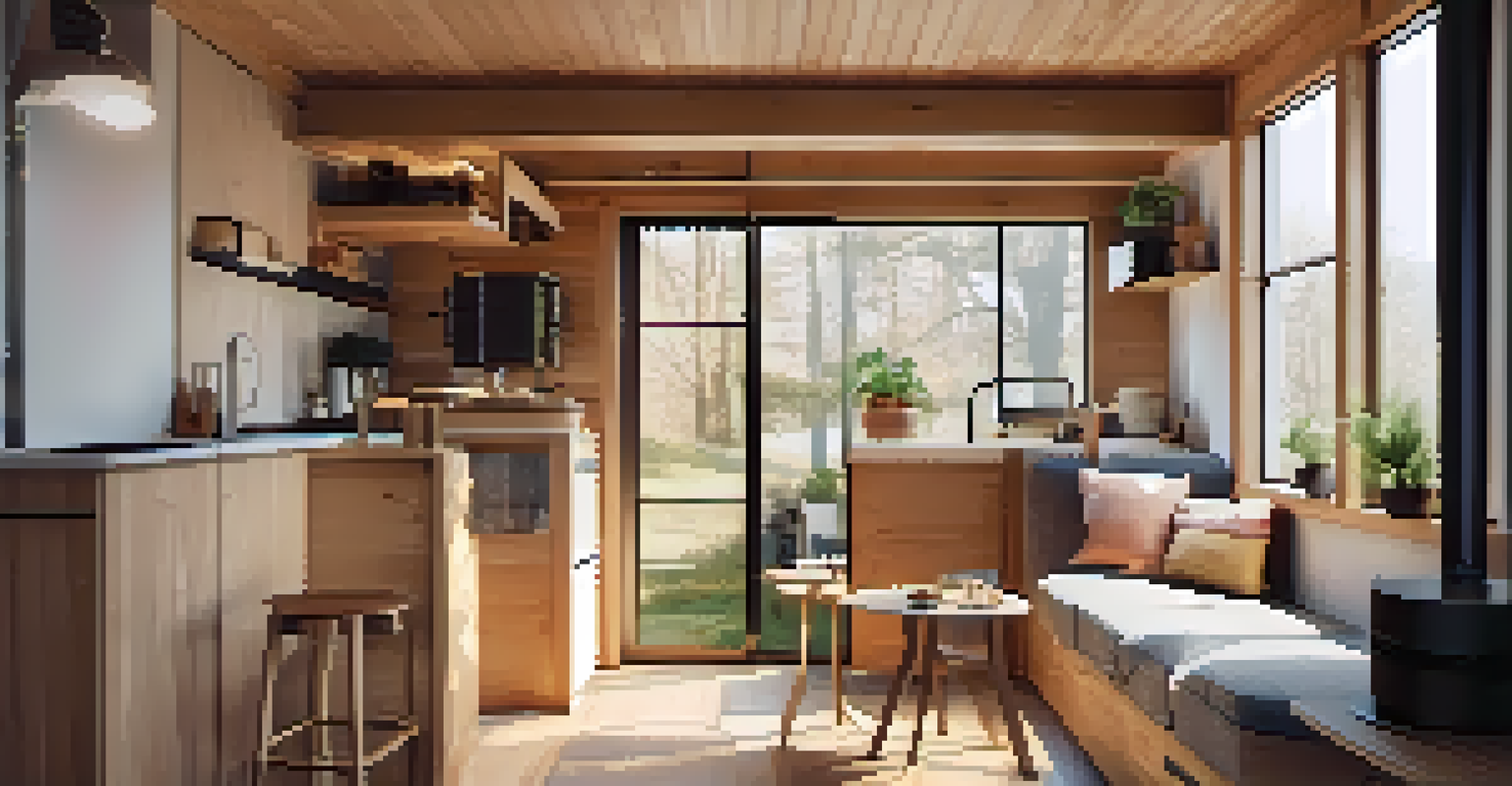Exploring the Trend of Remote Work and Tiny Homes

Understanding the Shift to Remote Work
In recent years, remote work has transitioned from a rare perk to a common practice. This shift was accelerated by the COVID-19 pandemic, which forced many companies to adapt to a remote workforce. Employees now enjoy the flexibility of working from anywhere, making it easier to balance personal and professional lives. Companies have also recognized the potential cost savings associated with reduced office space and overhead.
The ability to simplify means to eliminate the unnecessary so that the necessary may speak.
As remote work becomes increasingly normalized, people are seeking new lifestyles that align with this flexibility. Many are reevaluating their living situations, looking for spaces that reflect their evolving needs. This desire for change is driving interest in alternative housing solutions, with tiny homes emerging as a popular choice.
The combination of remote work and the quest for a simpler, more intentional lifestyle is reshaping the housing market. Tiny homes offer an appealing solution, providing affordable, sustainable living options that cater to the modern remote worker. With this trend, people are not just looking for a place to work; they are searching for a space that enhances their overall quality of life.
What Are Tiny Homes? A Quick Overview
Tiny homes are compact living spaces, typically ranging from 100 to 400 square feet. They are often designed with efficiency in mind, maximizing every inch to create functional and comfortable environments. This minimalist approach resonates with those who value simplicity and sustainability, making tiny homes an attractive option for many.

These homes come in various styles, from mobile tiny houses on wheels to stationary models built on foundations. Some are even designed as eco-friendly structures, incorporating renewable energy sources and sustainable materials. The flexibility in design allows homeowners to create spaces that reflect their personal tastes while minimizing their environmental footprint.
Rise of Remote Work Flexibility
The COVID-19 pandemic has accelerated the shift to remote work, allowing employees greater flexibility in balancing their personal and professional lives.
Tiny homes are not just about downsizing; they also represent a lifestyle choice. By reducing living space, individuals can declutter their lives, focusing on experiences rather than possessions. This shift aligns perfectly with the remote work trend, where flexibility and mobility are key.
The Benefits of Living in a Tiny Home
Living in a tiny home comes with a plethora of benefits, particularly for remote workers. First and foremost, the reduced living costs allow individuals to allocate funds toward experiences, travel, or savings. This financial freedom is especially appealing to those who may not want to be tethered to a traditional mortgage.
The future belongs to those who believe in the beauty of their dreams.
Another advantage is the low maintenance required for tiny homes. With fewer square footage and simpler designs, homeowners can spend less time cleaning and maintaining their space, allowing for more time spent on work and leisure activities. This liberation from upkeep is a game-changer in achieving a balanced lifestyle.
Additionally, tiny homes encourage a sense of community. Many tiny home villages are emerging, fostering connections among like-minded individuals. This communal living offers not just a support system but also a shared experience that enhances the remote work lifestyle.
Challenges of Tiny Home Living
Despite their many benefits, living in a tiny home is not without challenges. The most significant hurdle is often zoning and legal restrictions, which can complicate the process of finding suitable land. Many areas have strict regulations regarding the size and type of homes allowed, making it essential for potential tiny home dwellers to research local laws.
Another challenge is the limited space, which can be daunting for those used to larger homes. Adjusting to a smaller living area may require a significant mindset shift, as individuals must prioritize what belongings they truly need. This process of decluttering can be cathartic but also difficult for some.
Tiny Homes Meet Remote Work Needs
Tiny homes are emerging as an attractive living option for remote workers, offering affordability, sustainability, and a lifestyle that prioritizes simplicity.
Lastly, connectivity can be a concern for remote workers living in tiny homes, especially in rural areas. Reliable internet access is crucial for remote work, and finding a tiny home in a location that meets this requirement can be challenging. It's essential for prospective tiny home dwellers to consider their work needs before making a move.
The Intersection of Remote Work and Tiny Homes
As remote work continues to gain traction, the tiny home movement is flourishing alongside it. These two trends complement each other, providing a lifestyle that prioritizes flexibility, affordability, and sustainability. Remote workers are increasingly drawn to tiny homes as they seek spaces that align with their values and work styles.
The ability to travel while working remotely allows individuals to explore different locations without the burden of maintaining a larger home. Tiny homes facilitate this lifestyle, offering a portable and versatile solution for those who wish to live and work in various environments. This freedom to choose one's surroundings is a significant draw for many.
Moreover, tiny homes often include innovative workspaces designed for productivity. Many tiny home builders incorporate dedicated office areas, ensuring that remote workers have a comfortable and functional environment to complete their tasks. This thoughtful design helps bridge the gap between work and leisure, making it easier to thrive in a tiny home.
Embracing Minimalism for a Balanced Life
The tiny home movement encourages a minimalist lifestyle, which can lead to a more balanced and fulfilling life. By reducing physical possessions, individuals can focus on what truly matters, such as relationships and experiences. This intentional living resonates with the values of many remote workers who prioritize a work-life balance.
Minimalism also promotes mindfulness, as it encourages individuals to be more aware of their consumption habits. Living in a tiny home often requires thoughtful choices about what to bring into the space. This practice can help foster a deeper appreciation for the things that truly enhance one's life.
Challenges in Tiny Home Living
Despite their benefits, tiny homes present challenges such as zoning restrictions, limited space adjustments, and connectivity issues for remote workers.
Ultimately, embracing minimalism in tandem with remote work can lead to increased happiness and satisfaction. By simplifying their lives, individuals can create an environment that fosters creativity, productivity, and personal growth—key ingredients for success in both work and life.
Looking Ahead: The Future of Remote Work and Tiny Homes
As remote work becomes a permanent fixture in the modern workforce, the tiny home trend is likely to continue its upward trajectory. More people are realizing the possibilities of living in smaller spaces that offer flexibility and community. This shift could reshape the housing landscape, making tiny homes a mainstream option for many.
With advancements in technology and design, tiny homes are evolving to meet the needs of remote workers. Smart home features, eco-friendly materials, and customizable designs are becoming more prevalent, making them even more appealing. As the market grows, so too will the options available to those interested in embracing this lifestyle.

Ultimately, the convergence of remote work and tiny homes reflects a broader cultural shift towards valuing experiences over possessions. As more individuals seek harmony in their personal and professional lives, tiny homes offer a compelling solution that aligns with this new way of thinking—one that prioritizes freedom, connection, and sustainability.